ARTE: Lorraine O'Grady
 Thursday, December 15, 2011 at 5:00AM
Thursday, December 15, 2011 at 5:00AM 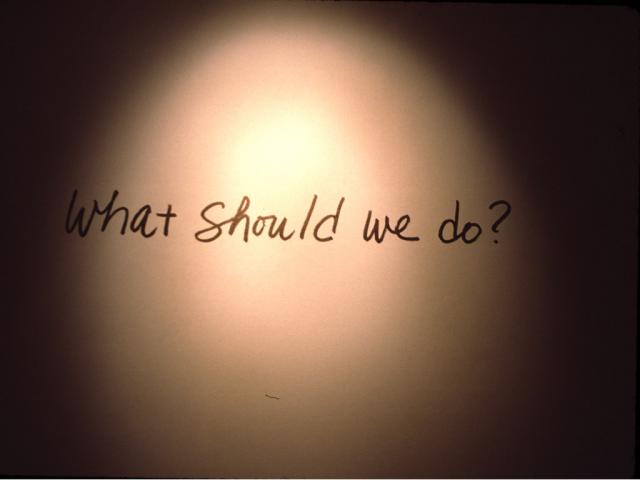 Installation view, “What should we do?” Lorraine O’Grady: Critical Interventions, INTAR Gallery, NYC, 1991
Installation view, “What should we do?” Lorraine O’Grady: Critical Interventions, INTAR Gallery, NYC, 1991
BRIEF BIO
Lorraine O’Grady is an artist and critic whose installations, performances, and texts address issues of diaspora, hybridity, and black female subjectivity. The New York Times in 2006 called her “one of the most interesting American conceptual artists around.” And in 2007 her landmark performance, Mlle Bourgeoise Noire, was made one of the entry points to WACK! Art and the Feminist Revolution, the first-ever museum exhibit of this major art movement.
Born in Boston in 1934 to West Indian parents, O’Grady came to art late, not making her first works until 1980. After majoring in economics and literature, she’d had several careers: as an intelligence analyst for the U.S. government, a successful literary and commercial translator, even a rock critic. Ultimately, her broad background contributed to a distanced and critical view of the art world when she entered it and to an unusually eclectic attitude toward artmaking. In O’Grady’s work, the idea tends to come first, and then a medium is employed to best execute it. Although its intellectual content is rigorous and political, the work is generally marked by unapologetic beauty and elegance.
Artist Lecture, Buffalo University, 2010 - “The Both/And,” powerpoint lecture. O’Grady provides an informal but full overview of her work, followed by a pointed question-and-answer period. HD: VIDEO
SELECTED WORKS
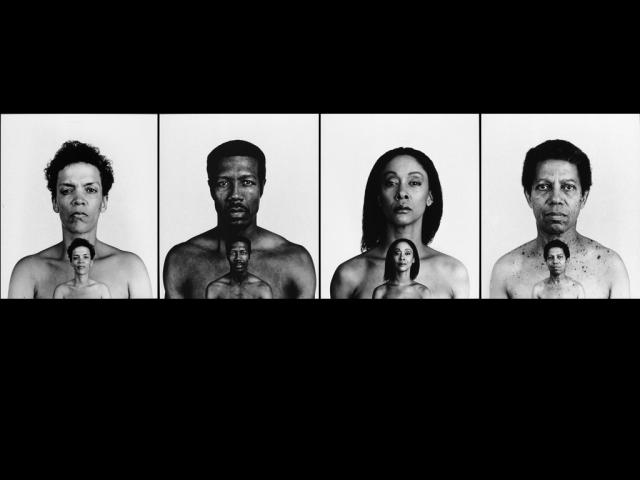 BodyGround, 1991: “Gaze,” black-and-white photomontage quadriptychBodyGround shorthand for Body Is the Ground of My Experience, refers to the photomontages produced by O’Grady for her first one-person exhibit, at INTAR Gallery, NYC, Jan 21–Feb 22, 1991. The phrase doesn’t name a series — the works were unrelated — but rather the concern shaping O’Grady’s writing, thinking, and art-making at the time. The photomontages reprised several ideas from Rivers, First Draft in still form. Her move from performance to the wall had financial, personal, and theoretical motives. The work was growing both more direct and more complex and needed repeated viewings.
BodyGround, 1991: “Gaze,” black-and-white photomontage quadriptychBodyGround shorthand for Body Is the Ground of My Experience, refers to the photomontages produced by O’Grady for her first one-person exhibit, at INTAR Gallery, NYC, Jan 21–Feb 22, 1991. The phrase doesn’t name a series — the works were unrelated — but rather the concern shaping O’Grady’s writing, thinking, and art-making at the time. The photomontages reprised several ideas from Rivers, First Draft in still form. Her move from performance to the wall had financial, personal, and theoretical motives. The work was growing both more direct and more complex and needed repeated viewings.
During her absence from the art world, O’Grady had become concerned about postmodernism’s over-simplifications which she felt re-located subjectivity away from the body to history in a way conveniently serving those in power. For while the body undoubtedly received history’s effects and was shaped by them, it was also, in an excess, the location of resistance. To make the point, her new photomontages — made the old-fashioned way just before Photoshop — eschewed both her earlier work’s layered beauty and postmodern photography’s dry formalism. Instead, they employed a psychological literalness reminiscent of Surrealism. In the Gaze and Dream quadriptychs, the bodies schematically enact both subjectivity’s stunting by history and latent resistance to it. And a group of three images, including The Strange Taxi and The Fir-Palm, employ a black body as a literal ground on which history acts but is unexpectedly modified.
O’Grady had not anticipated the intensely negative response, especially from white male viewers, to The Clearing, a diptych showing black and white bodies in what director John Waters calls “the last taboo.” One white male Harvard professor told her it was difficult to look at because it showed “how erotic domination is.” During this period, O’Grady experienced more success, especially with female audiences, via writings such as “Olympia’s Maid” and the articles in Artforum.
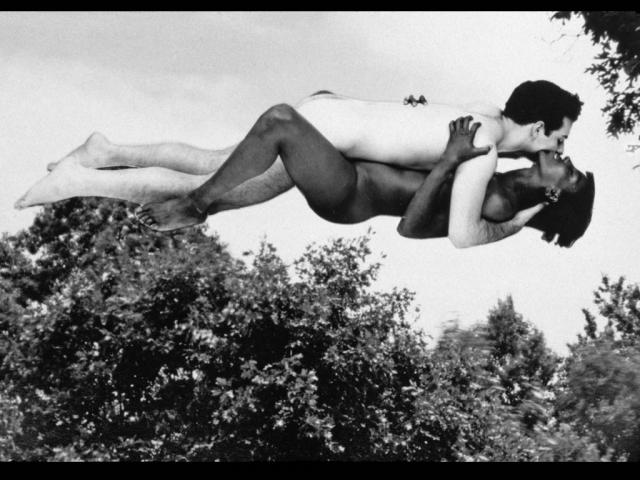 “The Clearing: or Cortez and La Malinche. Thomas Jefferson and Sally Hemings"Cutting Out the New York Times
“The Clearing: or Cortez and La Malinche. Thomas Jefferson and Sally Hemings"Cutting Out the New York Times
other media 1977
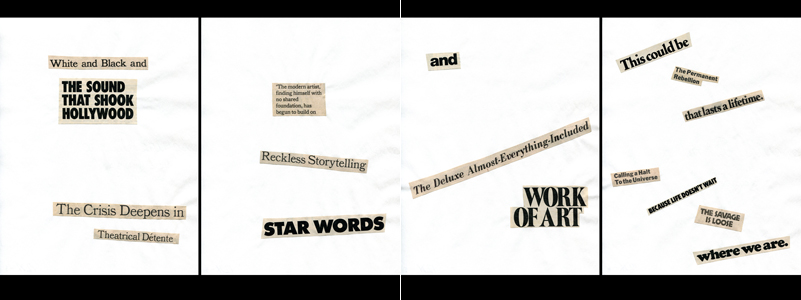
Cutting Out The New York Times is a series of 26 “cut-out” or “found” newspaper poems made by O’Grady on successive Sundays, from June 5 to November 20, 1977. They were first exhibited to the public at Daniel Reich Temp. at the Chelsea Hotel, in March 2006 at the urging of curator Nick Mauss. The slideshow here contains four of the poems in their entirety.
After graduating from college in the late 50s with a major in economics, O’Grady worked for five years as a young intelligence officer for the Departments of Labor and State, first on African and then on Latin American affairs. During that period, she was forced to read 10 national and international newspapers a day and — in the lead up to the Cuban Missile Crisis — three complete daily transcripts in Spanish of Cuban radio stations, as well as the endless overnight classified reports from agents in the field. It was a time, she’s written, when language “collapsed” for her, “melted into a gelatinous pool.” She soon quit her job as an intelligence analyst and began a roundabout journey into art.
1977 found her at SVA in New York, where her course in “Futurist, Dada and Surrealist Literature” attracted such students as John Sex, né John McLaughlin, Keith Haring, Kembra Pfahler, Luis Stand, and others. Cutting Out The New York Times was done in a moment of combined psychological and physical trauma (she’d just had a biopsy on her right breast which proved negative) and was accidentally begun while browsing the Sunday Times to make a thank-you collage for her doctor. She’d involuntarily wondered: what if, unlike Tzara and Breton’s random newspaper poems, she forced randomness back to meaning, rescued a personal sensibility from the public language that had swamped it, might she not get — rather than Plath and Sexton’s confessional poetry which made the private public — a “counter-confessional” poetry that could make the public private again? But with the rescue act accomplished, she forgot about the cutouts until Nick Mauss’s studio visit 30 years later.
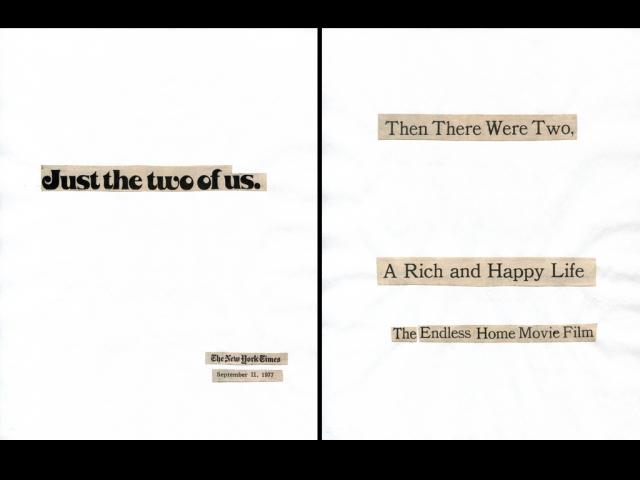
Artist Statememt: Re Cutting Out the New York Times, 2006
Andre S. Belcher - Contributor

Reader Comments